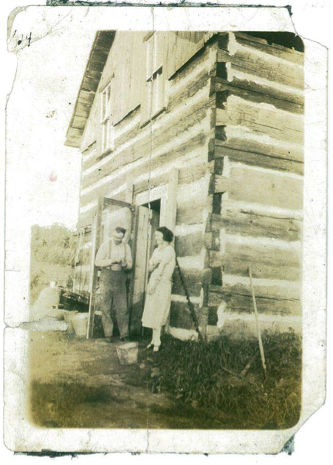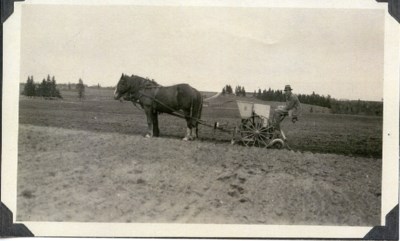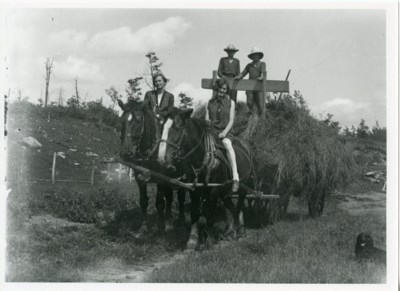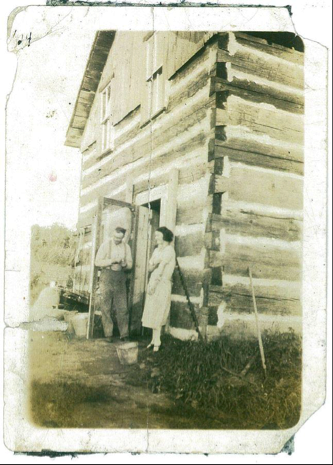The history of farming in North Bay dates back to the development of the city. Although areas south of us (like Powassan and Nipissing Village) had settlement farms that supplied the lumber camps, North Bay did not develop farms until the Canadian Pacific Railroad arrived in 1882. Every type of livestock was raised to feed both rail workers and the growing city population, but growing potatoes and dairy farming proved most successful on our rocky soil.
The story of the Souter and Parfitt farms in what was once known as Widdifield Township provide an idea of how local farms developed.
 Original Parfitt Log Home, 1920s. Courtesy of William Parfitt.
Original Parfitt Log Home, 1920s. Courtesy of William Parfitt.The Parfitt family farm was first surveyed in 1885. Current owner William Parfitt’s father Christopher purchased the farm in 1919 through a soldier’s settlement following the Great War. Little is known about the original owners who established and briefly tended to the land.
When the Parfitt family took over the farm, the land was stony and difficult to cultivate. The soil was acidic and dolomite limestone was added to remedy the composition. The Parfitts learned about farming through experience and hard work. The farm’s consistent cash crops include turnips and potatoes. (1)
 Carr Souter, Planting Potatoes 1935-1939. Courtesy of Ken Soutar.
Carr Souter, Planting Potatoes 1935-1939. Courtesy of Ken Soutar. A copy of the North Bay Nugget from October 2nd, 1939 highlights the results of this “scientific farming” As recommended, Carr chose to focus his attention almost entirely on potatoes and saw a harvest of almost 5,000 bags of potatoes from a 25-acre plot. The Souters also had 17 head of livestock including 12 cows, whose milk was shipped to North Bay. (2)
Carr Souter, Planting Potatoes 1935-1939. Courtesy of Ken Soutar.
 Unidentified farming image.
Unidentified farming image. Though few working farms remain within the city boundaries, the Museum is hoping to find citizens with photos and memories of farm life in the area to add to an exhibit profiling local farms.
The Museum is also looking for help identifying farms pictured in our local history photo collection such as the one displayed below.
Please visit Discovery North Bay Museum’s website at http://www.discoverynorthbay.com/farms-of-north-bay.html or contact museum volunteer Pat Moulson, [email protected] for more information or to get involved.
References:
1 “Historical Evaluation of the Parfitt Farm, Municipal Heritage Committee, North Bay, 2013
2 “Scientific Farming Has Proven its Worth in Growing of Potatoes,” The North Bay Nugget, 2 October 1939
3 “Farming Also Thrives in Nipissing District,” Family Herald and Weekly Star, 2 October, 1940



